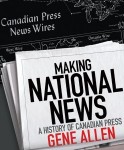Prof. Gene Allen has compiled a history of The Canadian Press from a corporate secretary’s perspective. I didn’t think that was possible. Writing about a newsroom without the people is like writing about the circus without the big top: ‘Shareholders were disappointed with the quarterly dividend when – whoa! Did that guy just get mauled by a snow leopard?’
Making National News covers ground already ploughed in The Story Of The Canadian Press, a 1948 account by former CP president Mark Nichols of the Winnipeg Tribune. Neither is compelling.
The story of any organization – a newsroom, a box factory, a daycare centre – is the story of humans. Allen, a professor of journalism at Ryerson University, appears to miss the point. The result is predictably lifeless. An example is his story of Jack Best.
Now retired in Ottawa, Best was CP’s man in the USSR in the mid-1960s. He’d have fascinating anecdotes of missile parades, the toppling of Khrushchev, the every-day dysfunction that inspired dark Soviet humour: what’s one kilometre long and eats cabbage? The lineup outside the meat shop.
Prof. Allen does not appear to have interviewed Jack Best. Instead he pulled his material from the corporate minutes: “In 1964, CP sent Jack Best, a reporter from the Ottawa bureau who had done well on previous international assignments, to Moscow. Although Best was described as a ‘resident correspondent’, the executive committee did not see this as a long term commitment – it was initially supposed to end by May 1965, then extended to until (sic) May 1966. After 18 months, it was decided to keep the bureau open indefinitely. The cost of keeping Best in Moscow was the main element in a $40,000 increase for international coverage in the 1966 budget.”
There you have it: an eyewitness account of the Cold War reduced to a line item in the annual budget.
As the country’s first truly national news agency, CP was born as a wartime propaganda arm of the Government of Canada. They kept it afloat from 1917 to 1923 with a $50,000-a year subsidy – a huge sum, the equivalent of $769,000 today.
Canadian Press’ first war correspondent was a former police reporter named Tom Lyon. When Lyon died in 1946 obituary writers insisted he “saw firsthand” the combat on the Western Front. “Possessed of an almost fanatical desire to get the facts, he tramped many weary miles to see things for himself,” the Globe recalled. This was untrue. Lyon covered the Battle of Vimy Ridge from his desk in London. He was, however, so adept in the boardroom that in 1934 he was Liberal appointee as the $10,000-a year chair of the Ontario Hydro Commission. It was good work in Depression years when CP was cutting reporters’ pay. These anecdotes are not to be found in Prof. Allen’s book.
Canadian Press matured. It set a standard for crisp news copy and coverage of the remotest corners of Canada. For generations it was a source of $10 cheques for small town stringers who’d call in copy on a local murder trial or hotel fire; I was one of them.
Newsrooms I have known are so lively, so dysfunctional, so ego-driven, I couldn’t imagine stripping the experience of its humanity.
Gene Allen found a way.
By Holly Doan
Making National News: A History Of Canadian Press by Gene Allen; University of Toronto Press; 218 pages; ISBN 9781-4426-15328; $34.95 





